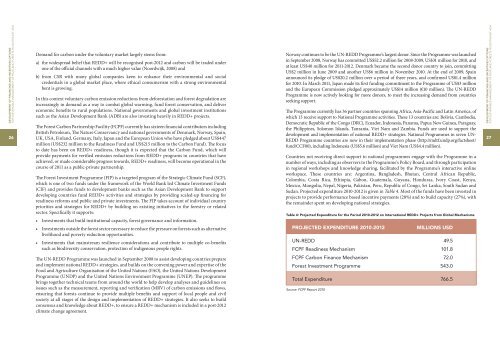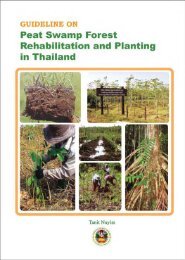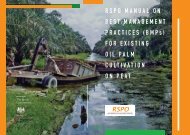Untitled - Peat Portal
Untitled - Peat Portal
Untitled - Peat Portal
Create successful ePaper yourself
Turn your PDF publications into a flip-book with our unique Google optimized e-Paper software.
DEVELOPMENT OF FINANCING AND INCENTIVES OPTIONSFOR SUSTAINABLE MANAGEMENT OF PEATLAND FORESTS IN SOUTHEAST ASIA26Demand for carbon under the voluntary market largely stems from:a) the widespread belief that REDD+ will be recognised post-2012 and carbon will be traded underone of the official channels with a much higher value (Noordwijk, 2008) andb) from CSR with many global companies keen to enhance their environmental and socialcredentials in a global market place, where ethical consumerism with a strong environmentalbent is growing.In this context voluntary carbon emission reductions from deforestation and forest degradation areincreasingly in demand as a way to combat global warming, fund forest conservation, and delivereconomic benefits to rural populations. National governments and global investment institutionssuch as the Asian Development Bank (ADB) are also investing heavily in REDD+ projects.The Forest Carbon Partnership Facility (FCPF) currently has sixteen financial contributors includingBritish Petroleum, The Nature Conservancy and national governments of Denmark, Norway, Spain,UK, USA, Finland, Germany, Italy, Japan and the European Union who have pledged about US$447million (US$232 million to the Readiness Fund and US$215 million to the Carbon Fund). The focusto date has been on REDD+ readiness, though it is expected that the Carbon Fund, which willprovide payments for verified emission reductions from REDD+ programs in countries that haveachieved, or made considerable progress towards, REDD+ readiness, will become operational in thecourse of 2011 as a public-private partnership.The Forest Investment Programme (FIP) is a targeted program of the Strategic Climate Fund (SCF),which is one of two funds under the framework of the World Bank led Climate Investment Funds(CIF) and provides funds to development banks such as the Asian Development Bank to supportdeveloping countries fund REDD+ activities and strategies by providing scaled-up financing forreadiness reforms and public and private investments. The FIP takes account of individual countrypriorities and strategies for REDD+ by building on existing initiatives in the forestry or relatedsector. Specifically it supports:• Investments that build institutional capacity, forest governance and information.• Investments outside the forest sector necessary to reduce the pressure on forests such as alternativelivelihood and poverty reduction opportunities.• Investments that mainstream resilience considerations and contribute to multiple co-benefitssuch as biodiversity conservation, protection of indigenous people rights.Norway continues to be the UN-REDD Programme’s largest donor. Since the Programme was launchedin September 2008, Norway has committed US$52.2 million for 2008-2009, US$31 million for 2010, andat least US$40 million for 2011-2012. Denmark became the second donor country to join, committingUS$2 million in June 2009 and another US$6 million in November 2010. At the end of 2009, Spainannounced its pledge of US$20.2 million over a period of three years, and confirmed US$1.4 millionfor 2010. In March 2011, Japan made its first funding commitment to the Programme of US$3 millionand the European Commission pledged approximately US$14 million (€10 million). The UN-REDDProgramme is now actively looking for more donors, to meet the increasing demand from countriesseeking support.The Programme currently has 36 partner countries spanning Africa, Asia-Pacific and Latin America, ofwhich 13 receive support to National Programme activities. These 13 countries are: Bolivia, Cambodia,Democratic Republic of the Congo (DRC), Ecuador, Indonesia, Panama, Papua New Guinea, Paraguay,the Philippines, Solomon Islands, Tanzania, Viet Nam and Zambia. Funds are used to support thedevelopment and implementation of national REDD+ strategies. National Programmes in seven UN-REDD Programme countries are now in their implementation phase (http://mdtf.undp.org/factsheet/fund/CCF00), including Indonesia (US$5.6 million) and Viet Nam (US$4.4 million).Countries not receiving direct support to national programmes engage with the Programme in anumber of ways, including as observers to the Programme’s Policy Board, and through participationin regional workshops and knowledge sharing, facilitated by the Programme’s interactive onlineworkspace. These countries are: Argentina, Bangladesh, Bhutan, Central African Republic,Colombia, Costa Rica, Ethiopia, Gabon, Guatemala, Guyana, Honduras, Ivory Coast, Kenya,Mexico, Mongolia, Nepal, Nigeria, Pakistan, Peru, Republic of Congo, Sri Lanka, South Sudan andSudan. Projected expenditure 2010-2012 is given in Table 4. Most of the funds have been invested inprojects to provide performance based incentive payments (28%) and to build capacity (27%), withthe remainder spent on developing national strategies.Table 4: Projected Expenditure for the Period 2010-2012 on International REDD+ Projects from Global MechanismsPROJECTED EXPENDITURE 2010-2012MILLIONS USDUN-REDD 49.5FCPF Readiness Mechanism 101.8DEVELOPMENT OF FINANCING AND INCENTIVES OPTIONSFOR SUSTAINABLE MANAGEMENT OF PEATLAND FORESTS IN SOUTHEAST ASIA27The UN-REDD Programme was launched in September 2008 to assist developing countries prepareand implement national REDD+ strategies, and builds on the convening power and expertise of theFood and Agriculture Organisation of the United Nations (FAO), the United Nations DevelopmentProgramme (UNDP) and the United Nations Environment Programme (UNEP). The programmebrings together technical teams from around the world to help develop analyses and guidelines onissues such as the measurement, reporting and verification (MRV) of carbon emissions and flows,ensuring that forests continue to provide multiple benefits and support of local people and civilsociety at all stages of the design and implementation of REDD+ strategies. It also seeks to buildconsensus and knowledge about REDD+, to ensure a REDD+ mechanism is included in a post-2012climate change agreement.FCPF Carbon Finance Mechanism 72.0Forest Investment Programme 543.0Total Expenditure 766.5Source: FCPF Report 2010





